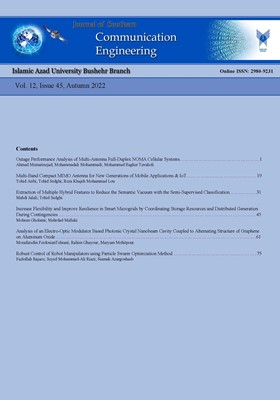-
-
List of Articles
-
Open Access Article
1 - Outage Performance Analysis of Multi-Antenna Full-Duplex NOMA Cellular Systems
Ahmad Memarinejad Mohammadali Mohammadi Mohammad Bagher Tavakoli -
Open Access Article
2 - Multi-Band Compact MIMO Antenna for New Generations of Mobile Applications & IoT
Tohid Aribi Tohid Sedghi Reza Khajeh Mohammad Lou -
Open Access Article
3 - Extraction of Multiple Hybrid Features to Reduce the Semantic Vacuum with the Semi-Supervised Classification
Mahdi Jalali Tohid Sedghi -
Open Access Article
4 - Increase Flexibility and Improve Resilience in Smart Microgrids by Coordinating Storage Resources and Distributed Generation During Contingencies
Mohsen Gholami Mehrdad Mallaki -
Open Access Article
5 - Analysis of an Electro-Optic Modulator Based Photonic Crystal Nanobeam Cavity Coupled to Alternating Structure of Graphene on Aluminum Oxide
Mozafaredin FerdosianTehrani Rahim Ghayour Maryam Mohitpour -
Open Access Article
6 - Robust Control of Robot Manipulators using Particle Swarm Optimization Method
Fazlollah Rajaee Seyed Mohammad-Ali Riazi Siamak Azargoshasb
-
The rights to this website are owned by the Raimag Press Management System.
Copyright © 2021-2025







